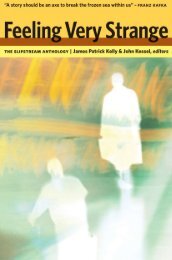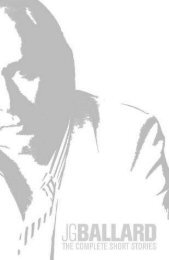The Curse of the Wer.. - Site de Thomas - Free
The Curse of the Wer.. - Site de Thomas - Free
The Curse of the Wer.. - Site de Thomas - Free
Create successful ePaper yourself
Turn your PDF publications into a flip-book with our unique Google optimized e-Paper software.
142 THE CURSE OF THE WEREWOLF<br />
also a werewolf, gui<strong>de</strong>s him through <strong>the</strong>se difficulties, sharing with<br />
him her own experiences. ‘[W]hen I first began, I killed people, too’,<br />
she tells him. 44<br />
But <strong>the</strong>n it changed. As <strong>the</strong> nights went by, I did not want to kill. I wanted<br />
to run, and nothing more. And when I had to move, and to keep moving,<br />
because <strong>the</strong>re was always someone beginning to discover me, I was not<br />
running away from what I had done. I was surviving, and learning <strong>the</strong><br />
sort <strong>of</strong> creature I was really meant to be. 45<br />
By <strong>the</strong> end <strong>of</strong> <strong>the</strong> novel, Benjamin is no longer <strong>the</strong> man with ‘a safe<br />
and an <strong>of</strong>fice’ he once was. 46 He reflects that ‘I was not a man, now,<br />
and I was not a wolf. I was one <strong>of</strong> those o<strong>the</strong>r creatures, <strong>the</strong> beings <strong>of</strong><br />
legend, who arrive with <strong>the</strong> amazing, miraculous news, and vanish.’ 47<br />
Having confronted his Shadow, Benjamin has moved on to <strong>de</strong>velop a<br />
more harmonized and enlightened subjectivity that transcends both<br />
man and wolf.<br />
Somtow’s Moon Dance also adopts a Jungian approach, through<br />
its characterization <strong>of</strong> a young werewolf with a multiple personality<br />
disor<strong>de</strong>r. By prioritizing <strong>the</strong> psychic conflict between <strong>the</strong> boy and wolf,<br />
it draws from <strong>the</strong> dualistic representations <strong>of</strong> <strong>the</strong> werewolf associated<br />
with <strong>the</strong> genre <strong>of</strong> horror; but <strong>the</strong> novel also <strong>de</strong>velops a narrative about<br />
<strong>the</strong> boy’s individuation (or <strong>the</strong> unification <strong>of</strong> his disjointed parts in <strong>the</strong><br />
role <strong>of</strong> Saviour) more typical <strong>of</strong> fantasy. Following a Jungian logic, <strong>the</strong><br />
boy’s psyche is visualized as consisting <strong>of</strong> many components: ‘I am a<br />
single body with many souls. <strong>The</strong>re are evil men and good men within<br />
me, young and old, male and female and even winkte, man–woman.’ 48<br />
<strong>The</strong> novel also emphasizes that such subjective experience is inevitably<br />
situated within <strong>the</strong> broa<strong>de</strong>r parameters <strong>of</strong> nature — an emphasis that is<br />
given full expression in <strong>the</strong> novel’s finale, when <strong>the</strong> werewolf Messiah<br />
un<strong>de</strong>rtakes <strong>the</strong> mystical Moon Dance.<br />
<strong>The</strong> light swirled about <strong>the</strong> boy’s head. It seemed … that he was growing in<br />
stature, making up for <strong>the</strong> years he had been trapped in <strong>the</strong> body <strong>of</strong> a little<br />
boy … now he seemed on <strong>the</strong> brink <strong>of</strong> adolescence … now it was summer<br />
and <strong>the</strong> grass rustled and his gol<strong>de</strong>n hair was flung back as <strong>the</strong> hot wind<br />
raced over <strong>the</strong> plain and now it was autumn and <strong>the</strong> wind stripped <strong>the</strong><br />
leaves from <strong>the</strong> oaks and roared and <strong>the</strong> grass was matted with rain. 49





